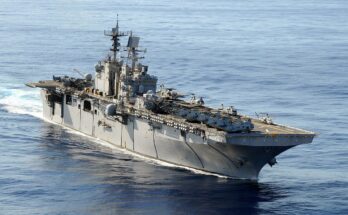
On January 25, the German government announced it would transfer an initial 14 Leopard 2 tanks to Ukraine and allow other NATO allies to likewise transfer Leopard 2s to Ukraine. This announcement represented the conclusion of months of wrangling between NATO members over the transfer of high-end main battle tanks to Ukraine.
On March 27, the German Federal Ministry of Defense announced the formal transfer of 18 Leopard 2A6 tanks (an increase of four tanks over the original pledge) at the Ukraine border. Elsewhere in Europe, Portugal is contributing three Leopard 2A6 tanks and Sweden 10. Poland, meanwhile, has supplied Ukraine with a battalion of Leopard 2A4 tanks, and Spain is contributing another six Leopard 2A4s.
Since February, Ukrainian tank crews have reportedly been training on the Leopard 2A6 at the Bundeswehr facility in Münster, in Lower Saxony.
On April 14, the Canadian Defense Minister announced Canada has completed delivery of 8 Leopard 2A4 tanks to Poland, for transfer to Ukraine.

In addition to the Leopard 2s, Denmark is reportedly transferring 100 refurbished Leopard 1 tanks to Ukraine.
Ukraine also claims the arrival of an unspecified number of British-made Challenger 2 tanks. In January, the British government pledged 14 Challenger 2 tanks for Ukraine. On March 4, the British Ministry of Defence said there are no plans to double the commitment to 28 tanks, as has been rumored.

These Leopard and Challenger tanks could possibly be ready for action in time for the spring offensive season in Ukraine.
Meanwhile, across the pond . . .
On January 25, the Biden administration announced it would transfer 31 M1A2 Abrams main battle tanks and eight M88A2 HERCULES armored recovery vehicles to Ukraine, in an emergency aid package worth $400 million. The Biden administration claimed Ukraine could expect to receive “hundreds” of tanks. No further details were provided at the time.

On March 21, however, the U.S. Department of Defense announced it would be sending refurbished M1A1 Abrams tanks instead of the more advanced M1A2, with deliveries by the fall of this year. Regarding Ukrainian tank crew training on the Abrams, the DoD would only say such training “is also in the works.”
The Forecast International Weapons Group notes two significant aspects to this story.
First, the NATO members are making good on their claim that the Leopard 2s would require minimal turnaround time for shipment to Ukraine, while transfers of Abrams tanks would take months. Whether or not they have succeeded in establishing a sophisticated logistical infrastructure – including maintenance capability, spare parts, fuel, lubricants, and ammunition – in Ukraine to support these tanks remains to be seen. This question also applies to the training of Ukrainian personnel to operate, maintain, and effectively employ these tanks. That level of training simply does not happen overnight. Even the most sophisticated weapon in the world is utterly useless in untrained (or poorly trained) hands. Nevertheless, the NATO members did succeed in getting Leopard 2 tanks to Ukraine in only two months.
As for the second point . . . Despite the Biden administration’s grand pronouncements that the M1A2 Abrams tanks would be a game-changer in the war, the fact remains that Ukraine will not be receiving M1A2s, and will not receive the older M1A1s for at least another five months – well after the spring offensive. The M1A1 is an extremely capable and advanced main battle tank. Just ask the survivors of the late Iraqi Army who faced it in 1991 and 2003. But it is not what the White House promised. And the current projected delivery time almost ensures the tanks will not see action in Ukraine until possibly next year.
So what is going on here?
The White House made the January announcement of M1A2 Abrams transfers to Ukraine a matter of diplomatic virtue signaling, as a means of prodding the European NATO members into action over Leopard 2 transfers. And it worked. But now, with Leopard 2 and Challenger 2 transfers to Ukraine proceeding, the sense of urgency for Abrams transfers has ebbed somewhat.
In the opinion of the Forecast International Weapons Group, this has allowed those within the U.S. Army who were no doubt never sanguine about the prospect of state-of-the-art Abrams tanks possibly falling into Russian hands in Ukraine to delay the transfers as much as possible, perhaps even to where the promised transfers might become a moot point.
Cooler heads may be at least trying to prevail.
Forecast International’s Military Vehicle Forecast provides long-range forecasts on tanks, light tracked and wheeled vehicles, tactical logistics vehicles, and engineering vehicles. The M1 Abrams, Leopard 2, M88A2, M998 Series HMMWV, MRAP, and AAV7/LVTP7 – these are just a sampling of the vehicles featured in this product. An annual subscription includes 81 individual reports, most with a 10-year unit production forecast. Click here to learn more.
Dean is responsible for Military Vehicles Forecast and Ordnance & Munitions Forecast. Prior to joining Forecast International, Dean served as an intelligence analyst in the U.S. Army for 10 years. As an Order of Battle and weapons specialist, he served in a variety of assignments, ranging from running the intelligence section of an Apache attack helicopter squadron in combat to representing a theater-level intelligence organization in a national-level interagency intelligence working group. His intelligence assignments have included duty in Japan, Korea, the Netherlands, Germany, Turkey and Iraq, as well as Fort Hood, Texas, and Norfolk, Virginia.




